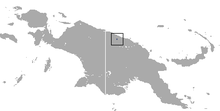Northern glider
| Northern glider[1] | |
|---|---|
| Scientific classification | |
| Domain: | Eukaryota |
| Kingdom: | Animalia |
| Phylum: | Chordata |
| Class: | Mammalia |
| Infraclass: | Marsupialia |
| Order: | Diprotodontia |
| Family: | Petauridae |
| Genus: | Petaurus |
| Species: | P. abidi |
| Binomial name | |
| Petaurus abidi Ziegler, 1981 | |
 | |
| Northern glider range | |
The northern glider (Petaurus abidi) is a species of marsupial in the family Petauridae. It is endemic to Papua New Guinea, becoming known to science in 1981 after being discovered in the Torricelli Mountains.[3] This species has been found in primary, mid-montane tropical moist forests. It is also known from rural gardens close to forest. The northern glider is Critically Endangered because its occurrence is less than 100 km2, all individuals are located within a single area, and a continuing decline of its habitat quality due to deforestation and human encroachment. They also face a major threat from hunting.[2]
Appearance[edit]
The northern glider ranges in weight of 228–332 grams. Its silky-like fur is gray on the top half, paler on the bottom regions, and includes the characteristic dark dorsal stripe of the family Petauridae that typically begins from the head extending to the base of tail.[4]
References[edit]
- ^ Groves, C. P. (2005). Wilson, D. E.; Reeder, D. M. (eds.). Mammal Species of the World: A Taxonomic and Geographic Reference (3rd ed.). Baltimore: Johns Hopkins University Press. p. 45. ISBN 0-801-88221-4. OCLC 62265494.
- ^ a b Leary, T.; Wright, D.; Hamilton, S.; Singadan, R.; Menzies, J.; Bonaccorso, F.; Salas, L.; Dickman, C.; Helgen, K. (2016). "Petaurus abidi". IUCN Red List of Threatened Species. 2016: e.T16726A21959298. doi:10.2305/IUCN.UK.2016-2.RLTS.T16726A21959298.en. Retrieved 16 November 2021.
- ^ Ziegler, A.C. (1981). "Petaurus abidi, a new species of glider (Marsupialia: Petauridae) from Papua New Guinea". Australian Mammalogy. 4 (2): 81–88. doi:10.1071/AM81002. S2CID 254708237.
- ^ Nowak, Ronald M. (1999) "Lesser Gliding Possums", pp. 139-40 in Walker's Mammals of the World. Baltimore: Johns Hopkins UP. ISBN 0-8018-5789-9


 French
French Deutsch
Deutsch